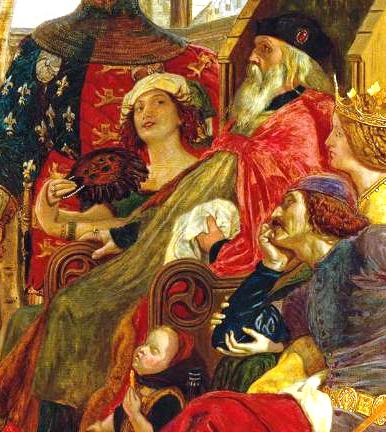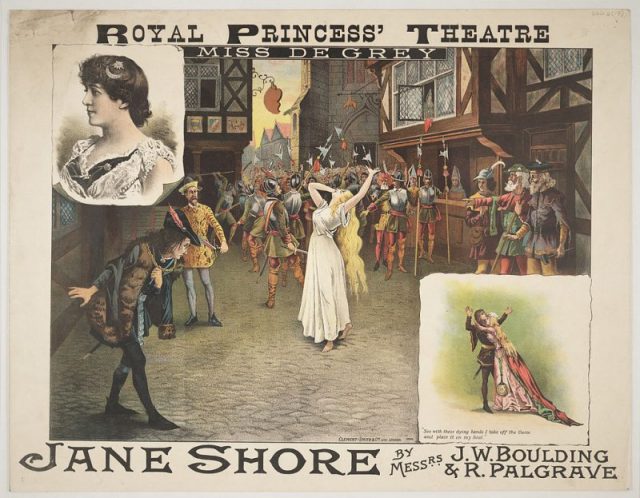For centuries, the job of mistress to a king has come with certain benefits, along with whatever romantic excitement the royal amour enjoyed: jewelry and other gifts, property, and perhaps positions at court for relatives and friends.
But when the king in question died, things could turn tricky very, very fast. Often the king’s heir and the rest of the “legitimate” family were hostile to the former favorite. Without protection of the royal lover, smiles turned into frowns all around.
One example is Alice Perrers, the mistress of Edward III, described as a “wanton woman” by one contemporary chronicler. Thanks to her affair with the much older king, Alice became the wealthiest woman in England. There is one story, perhaps slanderous, that when Edward III lay dying in 1377, Alice was busy stripping the rings off his fingers. What can be confirmed is that she was banished from the kingdom after the King was declared dead and her lands made forfeit.

Three centuries later, when it was Charles II who lay dying, the fate of one of his mistresses was very much on his mind. He sent for his brother, the soon to be King James II, and begged him “not to let poor Nellie starve.” For years, Charles II, the “Merry Monarch,” had been the lover of the “pretty, witty” actress Nell Gwynne. (James II may not have been England’s favorite king, but he did pay Nell’s debts and mortgage, giving her a pension before she died of syphilis in 1687, three years after Charles II passed away.)
But the royal mistress who had the worst experience of all once she lost her kingly protector was Jane Shore, the lover of 15th century king Edward IV. In fact, Shore endured such a famous ordeal that it inspired no less than George R. R. Martin when he wrote the passage containing the “Walk of Shame” by Cersei Lannister. Martin later told Entertainment Weekly magazine that he based Cersei’s penance chapter in particular on Jane Shore, who was punished with a similar walk after the king she loved died.

“It was a punishment directed at women to break their pride,” Martin told Entertainment Weekly. “And Cersei is defined by her pride.” Martin sometimes takes episodes from real medieval history to inspire his plots in the series.
In one of the most unforgettable episodes of the HBO series, Cersei, who had been imprisoned by the violent religious group The Sparrows, is “freed” but before she can resume her life in the palace she is stripped nude and paraded through the streets, screamed at and pelted. As she is surrounded by people shouting obscenities, Cersei hears the word “Shame! Shame! Shame!” intoned over and over.
Jane Shore, who had a real life walk of shame in 1483, was hit with humiliation and misfortune after an early life that seems to have been filled with good fortune. She did not have the background of a common courtesan. She was born Elizabeth Lambert, her father a London mercer of good standing. She was married when young to William Shore, a prosperous goldsmith. After her marriage, she met the king.
Among the centuries of kings, Edward IV was one of England’s most extreme womanizers. He made a controversial marriage when he wed in secret a commoner, the widow Elizabeth Woodville, after he tried to force her to be his mistress and she threatened to stab herself if he took her without a wedding. Their marriage produced many children and seems to have been happy, but he continued to take mistresses and was known for discarding them suddenly and passing them along to his friends, which upset the ladies a great deal.
If he loved any of his extramarital conquests, it would have been Jane. She was gorgeous, called “the Rose of London,” according to one biographer. Her affair with the king began around 1476, and they stayed together until he died. (Jane divorced her husband.) Edward is said to have called her his “merriest” mistress; she was friendly and kind, with a sense of humor.
Edward IV died after a short illness at the age of 40 on April 14, 1483. Jane must have been very shocked, and her change of status was swift, although she did look after her immediate future, forming relationships with both Edward IV’s stepson, Thomas Grey, and Edward IV’s closest friend, William Hastings.

The attack on Jane did not come from Queen Elizabeth Woodville or her children, it came from Richard III, the late king’s brother. She was publicly condemned as a “shameful and mischievous woman.”
Richard took the throne after seeing to it that his two nephews, Edward V and his brother Richard, the Duke of York, were imprisoned in the Tower of London. The princes’ fate is unknown but they were not seen in public after the end of the summer of 1483.
Richard III was hated by some as a usurper–certainly, Queen Elizabeth feared him, as she fled to Westminster Abbey seeking sanctuary. After conspiracies formed against him, Richard III took action. Without trial, William Hastings was executed on charge of treason. In fact, he was killed within a few hours of King Richard accusing him at a council meeting, beheaded over a log.
Jane Shore was accused of carrying messages between Hastings and Queen Elizabeth to further their plots, while the dowager queen was still in sanctuary. Jane’s punishment for conspiring against Richard III was open penance in the streets of London. A contemporary source said she was being censored “for the life that she led with the said lord hastyngys.”
Jane was forced to walk through the city wearing nothing but a kirtle, which is a long petticoat, and a taper in her hands. She was jeered at but no physical harm is known to have come to her during this traumatic procession.
Afterward, Jane Shore was sent to Ludgate Prison. There she won the notice of the king’s solicitor general, who arranged her release, married her, and had a child with her. When Thomas More, the minister to Edward IV’s grandson, Henry VIII, saw Jane as an elderly woman in London, he wrote that her beauty could still be seen.
History did not record how Jane Shore felt after her walk of shame. But actress Lena Headey, who plays Cersei Lannister, told interviewers it was difficult to film this walk even though it was obviously not real.
“I don’t think anyone deserves that treatment,” Headey said to reporters afterward.
Nancy Bilyeau, the U.S. editor of The Vintage News, has written a trilogy of novels set in the court of Henry VIII: ‘The Crown,’ ‘The Chalice,’ and ‘The Tapestry.’ The books are for sale in the U.S., the U.K., and seven other countries. For more information, go to www.nancybilyeau.com.
